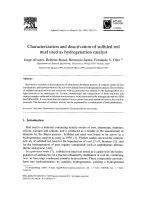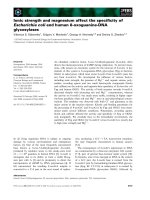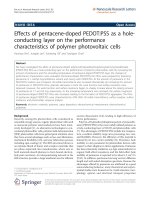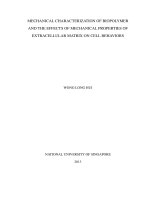The effects of ionic strength and temperature on the dissociation constants of adefovir and cidofovir used as antiviral drugs
Bạn đang xem bản rút gọn của tài liệu. Xem và tải ngay bản đầy đủ của tài liệu tại đây (156.05 KB, 9 trang )
Turkish Journal of Chemistry
/>
Research Article
Turk J Chem
(2014) 38: 806 – 814
ă ITAK
c TUB
doi:10.3906/kim-1309-39
The effects of ionic strength and temperature on the dissociation constants of
adefovir and cidofovir used as antiviral drugs
Hasan ATABEY, Hayati SARI∗
Chemistry Department, Science and Arts Faculty, Gaziosmanpa¸sa University, Tokat, Turkey
Received: 16.09.2013
•
Accepted: 13.03.2014
•
Published Online: 15.08.2014
•
Printed: 12.09.2014
Abstract: The effects of ionic strength and temperature on the dissociation constants of adefovir (PMEA) and cidofovir
(HPMPC) used as antiviral drugs were studied at 298 K, 308 K, and 318 K in aqueous media and at different ionic
strength backgrounds of NaCl potentiometrically. The dissociation constants of the ligands were determined via the
calculation of the titration data with the SUPERQUAD computer program. The thermodynamic parameters ( ∆G ,
∆H , and ∆S) for all species were calculated. The dissociation order of nitrogen and oxygen atoms in the ligands
according to proton affinities values were obtained using PM6 semiempirical methods. Moreover, p Ka values of the
ligands were determined at 0.00, 0.10, 0.15, 0.20, and 0.5 mol dm −3 ionic strength (NaCl) at 298 K. Consequently, when
the ionic strength and temperature in the titration cells were increased, the obtained dissociation constants of PMEA
(p Ka3 , p Ka4 , and p Ka5 ) and HPMPC (p Ka2 and p Ka3 ) decreased.
Key words: Adefovir, cidofovir, proton affinities, dissociation constants, thermodynamic parameters
1. Introduction
Viruses are small infectious agents that can replicate only inside the living cells of an organism. 1 Some diseases
such as Ebola, AIDS, influenza, herpes, and SARS are caused by viruses and these diseases are described as viral
diseases. Treatment of viral diseases is difficult because viruses are highly resistant to extreme environmental
conditions. Therefore, few drugs are known for the treatment of viral diseases. One type of antiviral drugs
are acyclic nucleotide analogues (ANPs) such as adefovir, cidofovir, famciclovir, tenofovir, and penciclovir.2,3
The basic chemical structure of ANP compounds consists of a purine base (i.e. adenine, guanine, cytosine) or
a pyrimidine base attached to an acyclic side chain that ends in a phosphonate group. In this study, adefovir
and cidofovir were investigated with respect to ionic equilibria in aqueous solution. The chemical structures of
the PMEA and HPMPC are given in Figures 1a and 1b.
Adefovir [{[2-(6-amino-9H-purin-9-yl)ethoxy]methyl} phosphonic acid] (PMEA) has antiviral activity
against the hepatitis B virus. 4,5 Its oral pro-drug is adefovir dipivoxil, which is a butyl ester of PMEA. 6
Therefore, PMEA is used in the treatment of chronic hepatitis B. 7,8 In addition, in vitro PMEA has been shown
to be highly effective against hepadnaviruses, retroviruses, and herpesviruses. 9 Moreover, anti-HIV activity of
PMEA has been obtained against AIDS. 10
Cidofovir {HPMPC, 1-(S)-[3-hydroxyl-2-(phosphonomethoxy)propyl]cytosine} is an important anti-DNA
virus agent. 11−13 HPMPC prevents the spread of all DNA viruses 14 and it is used in the treatment of
∗ Correspondence:
806
ATABEY and SARI/Turk J Chem
cytomegalovirus retinitis in AIDS patients, 15 but it is also used in the treatment of papillomatosous infections, 16
progressive multifocal leukoencephalopathy, 17 adenovirus infections, 18 and some severe infections caused by
poxviruses. 19 According to anecdotal reports and some studies, HPMPC has been proposed as an auxiliary
therapy for highly active antiretroviral therapy (HAART) in AIDS. 20,21
(a)
(b)
Figure 1. Chemical structures of the ligands (a) PMEA (b) HPMPC.
Consequently, PMEA and HPMPC are extremely important compounds for human health. Therefore,
the complexes of ligands with Cu(II), Ni(II), Zn(II), Co(II), Ca(II), and Mg(II) metal ions were characterized
in our previous study. 22 However, ionic strength and temperature are 2 important variants in the human body.
Therefore, in the present study, the effects of ionic strength and temperature on the pKa values of PMEA and
HPMPC were investigated in aqueous solution using a potentiometric titration method that is frequently used
in this field. 23−27
2. Results and discussion
Dissociation constants were calculated by potentiometric titration from a series of several measurements, where
LH 5+
and LH 2+
denote the fully protonated form of PMEA and HPMPC, respectively. All PMEA species are
7
4
LH 6 , LH 5 , LH 4 , LH 3 , LH 2 , and LH and the HPMPC species occurring in aqueous solution according to the
pH under our experimental conditions are LH 3 , LH 2 , and LH. Their dissociation equilibrium is as follows:
LHn + H2 O ⇌ LHn−1 + H3 O+ Kn = [LHn−1 ][H3 O+ ]/[LHn ]
(1)
Proton affinity gives some information about protonation order. In other words, it reflects the extent of the
basicity of donor atoms within the whole ligand. Therefore, the calculations of the proton affinity for the ligands
were carried out according to semiempirical molecule orbital (SE-MO) methods based on quantum mechanical
principles for examination of the structure of the species formed in the solution and to determine the protonation
order of both nitrogen and oxygen atoms in PMEA and HPMPC. SE-MO methods are utilized over a wide
area to determine the protonation sequence in polyprotic compounds. 28,29 The MOPAC 2009 software package
was used in all theoretical calculations. The formation heats (H f ) and total energies (TE) of the ligands and
monoprotonated species were calculated by semiempirical PM6 methods. 30−32 In addition, the proton affinity
(PA) of each ionizable atom in the ligands was found according to the following equation and is given in Table 1:
P A = 1536.345 + ∆Hf◦ (B) − ∆Hf◦ (BH + ),
(2)
807
ATABEY and SARI/Turk J Chem
where PA is the proton affinity of B types, ∆H ◦f (B) is the formation heat of B molecule, ∆ H ◦f (BH + ) is the
formation heat of BH + molecule, and 1536.345 is the formation heat of H + . 33
Table 1. The calculated formation heat (H f ) , total energy (TE), and PA values with PM6 methods for PMEA and its
monoprotonated forms.
Species
PMEA
1 N - H+
2 N - H+
3
3 N - H+
4 N - H+
5 N - H+
6 O - H+
2
7 O - H+
2
HPMPC
1 O - H+
2
2 O - H+
2
3 N - H+
3
4 O - H+
TE (kJ mol−1 )
–323.433
–324.718
–324.655
–324.718
–324.722
–324.613
–324.588
–324.718
–347.785
–348.773
–349.020
–348.890
–349.070
Hf (kJ mol−1 )
–648
–627
–565
–586
–632
–523
–435
–594
–1213
–866
–1113
–983
–1163
PA
1515
1453
1474
1520
1411
1323
1482
1819
1436
1306
1486
According to the calculated results (Table 1), the nitrogen atom in 4 positions in PMEA has the highest
PA. Therefore, the first protonated atom is nitrogen in 4 positions in the ligand because of having more basic
characters than the others. The most acidic center within the whole ligand is also the oxygen atom in 6 positions.
Thus, the protonation order of donor atoms in PMEA is 4N - 1N - 7O - 3N - 2N - 5N - 6O. In other words, the
dissociation order of nitrogen and oxygen atoms in PMEA is 6O - 5N - 2N - 3N - 7O - 1N - 4N. In HPMPC,
the oxygen atom in 4 positions is the highest PA. Therefore, it has a more basic center than the others. Hence,
the first protonated site is 4O in this HPMPC. Moreover, the most acidic center within the whole ligand is 1O.
Therefore, the protonation order of potent donor atoms in HPMPC is 4O - 2O - 3N - 1O. In other words, the
dissociation order of nitrogen and oxygen atoms in HPMPC is 1O - 3N - 2O - 4O.
Finally, both ligands include phosphoric acid groups containing 2 acidic oxygen atoms. One of the 2 pKa
values of phosphoric acid groups is very low (pKa < 2). 34−38 Therefore, only one p Ka value was calculated
for phosphoric acid. Hence, 6 pKa values for PMEA and 3 pKa values for HPMPC were determined in this
study and our previous study. 22
2.1. Ionic strength effects on the dissociation constants of the ligands
Ion activity must be used instead of concentrations in all equilibrium calculations because ions in solution
interact with each other via Coulomb forces. These ions are not separately treated in the solution because of
these interactions. The relationship between concentration and activity has been explained by the DebyeHă
uckel
theory. Therefore, ionic strength changes are affected by the equilibrium constants of the ligands. The effect of
ionic strength on the p Ka values of PMEA and HPMPC was investigated and the results obtained are given
in Table 2 and Figures 2a and 2b.
In Table 2, p Ka3 , p Ka4 , and p Ka5 values generally decrease because of increasing ionic strength.
However, the values for p Ka1 and p Ka6 increase while irregular changes are observed for p Ka2 . Therefore,
while the proton release of some N–H or O–H bonds (pKa1 , p Ka6 ) decreases, for some bonds in PMEA (pKa3 ,
808
ATABEY and SARI/Turk J Chem
pKa4 , and p Ka5 ) proton release increases. Decreasing values were generally observed for pKa2 and pKa3 in
HPMPC. Nevertheless, disordered changes were observed for pKa1 values. Hence, it can be considered that
while the proton release of O–H bonds (pKa1 and pKa3 ) increases, it decreases for the N–H bond (p Ka1 ) in
HPMPC.
Table 2. Ionic strength effect ( I) (NaCl) on dissociation constants of the ligands at 298 K.
pKa values
Ligand
I: 0
3.65 ± 0.01
4.62 ± 0.02
6.96 ± 0.02
PMEA
7.62 ± 0.01
10.69 ± 0.03
10.96 ± 0.02
4.87 ± 0.02
HPMPC 7.31 ± 0.02
10.50 ± 0.03
I: 0.05
3.66 ± 0.02
4.58 ± 0.01
6.74 ± 0.02
7.43 ± 0.01
10.35 ± 0.02
11.19 ± 0.03
4.82 ± 0.01
7.10 ± 0.02
10.48 ± 0.02
I: 0.1*
3.83 ± 0.02
4.49 ± 0.01
6.64 ± 0.01
7.33 ± 0.01
10.41 ± 0.01
11.22 ± 0.04
4.91 ± 0.01
7.02 ± 0.03
10.31 ± 0.02
I: 0.15
3.75 ± 0.03
4.48 ± 0.02
6.56 ± 0.01
7.24 ± 0.01
10.33 ± 0.01
11.39 ± 0.03
4.78 ± 0.01
6.94 ± 0.02
10.27 ± 0.02
I: 0.2
3.83 ± 0.01
4.47 ± 0.02
6.51 ± 0.01
7.26 ± 0.02
10.36 ± 0.02
11.49 ± 0.06
4.97 ± 0.02
6.93 ± 0.03
10.24 ± 0.03
I: 0.5
3.79 ± 0.03
4.86 ± 0.07
6.50 ± 0.01
6.99 ± 0.02
10.17 ± 0.01
11.67 ± 0.03
5.01 ± 0.03
6.79 ± 0.03
10.13 ± 0.03
*Values were taken from ref. 22 and each titration was repeated 3 times
12
11
11
10
9
pKa1
pKa2
pKa4
pKa5
9
pKa1
pKa2
8
pKa3
pKa6
8
pKa3
pKa
pKa
10
7
7
6
6
5
5
4
3
0.0
(a)
0.2
0.4
√I
0.6
0.8
4
0.0
(b)
0.2
0.4
0.6
0.8
√I
Figure 2. p Ka values versus ionic strength (298 K, as background NaCl) (a) PMEA (b) HPMPC.
2.2. Calculation of the thermodynamic parameters of dissociation constants
The titration curves with NaOH as a titrant in water and at different temperatures and the dissociation constants
for the ligands were evaluated at 298 K, 308 K, and 318 K, and are given in Figures 3a and 3b and Table 3.
Figure 3 shows the titration curves for different temperatures (298 K, 308 K, and 318 K, respectively).
Comparing the titration curves of PMEA and HPMPC (Figure 3) at different temperatures shows that increasing
temperature shifts the titration curves to a more alkali region. This can simply be explained as a result of proton
release from the ligands. 39,40 Figures 4a and 4b show the effect of temperature on the dissociation constants of
PMEA and HPMPC, and pKa values of PMEA and HPMPC in different temperatures are given in Table 3.
A dissociation constant of a ligand is a direct consequence of the underlying thermodynamics of the
dissociation equilibria. Furthermore, pKa values directly proportional to the standard Gibbs energy change for
the equilibria. Therefore, pKa changes with temperature can be understood based on Le Chatelier’s principle.
Namely, when a reaction is endothermic, the pKa value decreases with increasing temperature; the contrary
809
ATABEY and SARI/Turk J Chem
is true for exothermic reactions. All the thermodynamic parameters of the dissociation process of PMEA and
HPMPC are recorded in Tables 4 and 5.
11
11
10
10
9
9
c
a
7
b - 308K
6
a
b
8
a - 298K
pH
pH
8
7
b - 308K
c
6
b
a - 298K
c - 318K
c - 318K
5
5
4
4
3
3
0
1
2
3
0
(b)
4
mL NaOH
(a)
1
2
mL NaOH
3
4
Figure 3. Titration curves in different temperatures for (a) PMEA and (b) HPMPC ( I : 0.1 mol dm −3 NaCl, 0.03
mmol HCl).
Table 3. p Ka values of PMEA and HPMPC in different temperatures ( I : 0.1 mol dm −3 NaCl, 0.03 mmol HCl).
PMEA
HPMPC
Temperatures
298 K
log 10 β∗
11.22 ± 0.02
21.68 ± 0.03
28.96 ± 0.04
35.59 ± 0.03
40.09 ± 0.04
43.92 ± 0.06
10.31 ± 0.04
17.33 ± 0.05
22.24 ± 0.06
(T/K)
pKa *
3.83 ± 0.02
4.49 ± 0.01
6.64 ± 0.01
7.33 ± 0.01
10.41 ± 0.01
11.22 ± 0.04
4.91 ± 0.01
7.02 ± 0.03
10.31 ± 0.02
308 K
log 10 β
11.23 ±
21.62 ±
28.95 ±
35.57 ±
40.07 ±
43.93 ±
10.23 ±
17.19 ±
21.83 ±
pKa
3.86 ± 0.02
4.51 ± 0.02
6.62 ± 0.02
7.33 ± 0.02
10.39 ± 0.02
11.23 ± 0.01
4.64 ± 0.01
6.97 ± 0.02
10.23 ± 0.02
0.02
0.02
0.02
0.02
0.02
0.06
0.03
0.03
0.03
318 K
log 10 β
11.42 ± 0.02
21.78 ± 0.02
29.20 ± 0.02
35.79 ± 0.02
40.07 ± 0.02
43.96 ± 0.01
9.98 ± 0.03
16.86 ± 0.02
21.37 ± 0.04
pKa
3.89 ± 0.01
4.28 ± 0.02
6.59 ± 0.02
7.42 ± 0.02
10.36 ± 0.02
11.42 ± 0.07
4.51 ± 0.01
6.88 ± 0.01
9.98 ± 0.03
-8
-8
-10
-12
-14
-16
-18
-20
-22
-24
-26
-28
-30
-10
lnKa1
lnKa2
-12
lnKa3
lnKa4
-16
lnKa5
lnKa6
-14
lnK
lnK
*Values were taken from ref. 22 and each titration was repeated 3 times
lnKa1
lnKa2
-18
lnKa3
-20
-22
-24
-26
0.00315
(a)
0.00320
0.00325
1/T
0.00330
0.00335
-28
0.00315
(b)
0.00320
0.00325
0.00330
0.00335
1/T
Figure 4. Effect of temperature on K values of the ligands ( I : 0.1 mol dm −3 NaCl, 0.03 mmol HCl) (a) PMEA (b)
HPMPC.
810
ATABEY and SARI/Turk J Chem
It can be concluded that thermodynamic values can be obtained since the pK H values of PMEA and
HPMPC decrease with increasing temperature (Table 4). If ∆H has a positive value, the dissociation process
shows endothermic properties. Conversely, the dissociation process shows exothermic properties. Large positive
values for ∆G indicate that the dissociation process is not spontaneous. 41
The following conclusions can be drawn from this discussion:
• The proton affinities of donor atoms of the ligands were calculated using PM6 semiempirical methods.
Hence, the dissociation order of nitrogen and oxygen atoms in the ligands was obtained as 6O - 5N - 2N
- 3N - 7O - 1N - 4N for PMEA and 1O - 3N - 2O - 4O for HPMPC.
• The effect of ionic strength effect (background NaCl) on the pKa values of PMEA and HPMPC was
investigated at 298 K in aqueous solution. While systematic changes were observed for some pKa values,
irregular changes were observed in other constants for both ligands.
• The effects of temperature on the dissociation constants of PMEA and HPMPC were studied at 0.1 mol
dm −3 ionic strength (NaCl) and, according to the obtained data, thermodynamic parameters ( ∆H , ∆S ,
and ∆G) were calculated for 298 K, 308 K, and 318 K temperatures. The results obtained are given in
Tables 4 and 5.
• These results could be of considerable assistance for advancing understanding of the drugs’ behavior in
vivo.
Table 4. Thermodynamic functions of PMEA ( I : 0.1 mol dm −3 NaCl).
T/K
298
308
318
298
308
318
298
308
318
298
308
318
298
308
318
298
308
318
Dissociation constants
pKa1 values
3.83
3.86
3.89
pKa2 values
4.49
4.51
4.28
pKa3 values
6.64
6.62
6.59
pKa4 values
7.33
7.33
7.42
pKa5 values
10.41
10.39
10.39
pKa6 values
11.22
11.23
11.42
Gibbs energy
kJ mol−1
∆G
21.85
22.76
23.68
∆G
25.62
26.59
26.06
∆G
37.88
39.03
40.12
∆G
41.82
43.22
45.17
∆G
59.39
61.26
63.07
∆G
64.01
66.22
69.52
Enthalpy
kJ mol−1
∆H
–5.44
∆H
18.80
∆H
4.52
∆H
–8.07
∆H
4.52
∆H
–17.96
Entropy
J mol−1 K−1
∆S
–91.58
–91.56
–91.58
∆S
–22.88
–25.31
–22.83
∆S
–111.93
–112.04
–111.93
∆S
–167.41
–166.53
–167.43
∆S
–184.11
–184.22
–184.10
∆S
–275.05
–273.29
–275.09
811
ATABEY and SARI/Turk J Chem
Table 5. Thermodynamic functions of HPMPC ( I : 0.1 mol dm −3 NaCl).
T/K
298
308
318
298
308
318
298
308
318
Dissociation constants
pKa1 Values
4.91
4.64
4.51
pKa2 values
7.02
6.97
6.88
pKa3 values
10.31
10.23
9.98
Gibbs energy
kJ mol−1
∆G
28.01
27.36
27.46
∆G
40.05
41.10
41.88
∆G
58.82
60.32
60.76
Enthalpy
kJ mol−1
∆H
36.41
∆H
12.66
∆H
29.76
Entropy
J mol−1 K−1
∆S
28.18
29.38
28.15
∆S
–91.92
–92.34
–91.91
∆S
–97.52
–99.23
–97.48
3. Materials and methods
3.1. Reagents
NaCl ( ≥ 99%) used in this research was purchased from Merck, potassium hydrogen phthalate (KHP) (≥ 99%)
and borax (Na 2 B 4 O 7 ) ( ≥ 99%) from Fluka, PMEA (99%) from Watson International Ltd., and HPMPC (98%),
0.1 mol dm −3 NaOH, and 0.1 mol dm −3 HCl as standard solution from Aldrich. All reagents were of analytical
quality and were used without further purification. CO 2 -free double-distilled deionized water obtained using
an aquaMAX T M - Ultra water purification system (Young Lin Inst.) was used throughout all the experiments;
its resistivity was 18.2 M Ω cm. pH-metric titrations were performed using a Molspin pH meter with an Orion
8102BNUWP ROSS ultra-combination pH electrode. The temperature in the double-wall glass titration vessel
was constantly controlled using a thermostat (± 0.1 ◦ C) (DIGITERM 100, SELECTA). The cell solution was
stirred during titration at a constant rate.
3.2. Procedures
First 0.05 mol kg −1 potassium hydrogen phthalate (KHP) and 0.01 mol kg −1 borax were prepared from the
reagents for the calibration of the electrode. Then 1 × 10 −3 mol dm −3 PMEA and HPMPC solutions were
prepared and used in all the experiments. The electrode pairs were calibrated according to the instructions of
the Molspin Manual 42 with buffer solutions (KHP) of pH 4.005, 4.018, and 4.038; and (Na 4 B 4 O 7 borax) of
pH 9.180, 9.102, and 9.038 at 298 K, 308 K, and 318 K temperatures, respectively. 43
◦
The potentiometric cell was calibrated to obtain the formal electrode potential Ecell at each ionic strength
and temperature change. 44,45 For this purpose, HCl solutions were prepared for each medium with titrated
NaOH solutions. For all the conditions examined, the reproducible values of the autoprotolysis constants Kw
were calculated from several series of [H + ] and [OH − ] measurements. Pure nitrogen gas (99.9%) was purged
from the solutions in the cell to obtain an inert atmosphere. Next, 1.0 mol dm −3 NaCl stock solution was
prepared and diluted to 0.00, 0.10, 0.15, 0.20, and 0.50 mol dm −3 , which were used as the ionic background
to maintain a constant ionic strength. An automatic burette was connected to a Molspin pH-mV-meter. The
SUPERQUAD 46 computer program was used for the calculation of the dissociation constants.
812
ATABEY and SARI/Turk J Chem
A solution containing approximately 0.01 mmol of PMEA/HPMPC was placed into the titration cell.
The required amount of 0.1 mol dm −3 HCl was added. While thermodynamic studies were carried out at
0.10 mol dm −3 ionic strength (NaCl), ionic strength studies were conducted at 298 K. Finally, doubly distilled
deionized water was added to the cell to make up the total volume of 50 mL. The pH data were obtained after
the addition of 0.03 cm 3 increments of the standardized NaOH solution. Each titration was repeated 3 times
and the standard deviations quoted refer to random errors only.
Furthermore, all titration measurements for 298 K, 308 K, and 318 K temperatures were carried out
and the thermodynamic parameters of equilibrium constants of PMEA and HPMPC were calculated for each
temperature. The slope of the plot p K H or log 10 K vs. 1/ T was utilized to evaluate the enthalpy change
(∆H) for the dissociation process, respectively
∆G = −2.30RT log10 K
(3)
∆S = (∆H − ∆G)/T
(4)
log10 K = (−∆H/2.303)(1/T ) + (∆S/2.303R)
(5)
or
From the ∆G and ∆H values, the entropy changes (∆S) can be calculated using the well-known equations
(Eqs. (3), (4), and (5)).
Acknowledgment
The author gratefully acknowledges the Scientific Research Council of Gaziosmanpa¸sa University for its financial
support (Project number: 2011/35).
References
1. Koonin, E. V.; Senkevich, T. G.; Dolja, V. V. Biol. Direct. 2006, 19, 1–29.
2. Holy, A. Nucleos. Nucleot. 1987, 6, 147–155.
3. De Clercq, E.; Sakuma, T.; Baba, M.; Pauwels, R.; Balzarini, J.; Rosenberg, I.; Hol´
y, A. Antiviral Res. 1987, 8,
261–272.
4. Cundy, K. C.; Barditchcrovo, P.; Walker, R. E.; Collier, A. C.; Ebeling, D.; Toole, J.; Jaffe, H. S. Antimicrob.
Agents Ch. 1995, 39, 2401–2405.
5. Ying, C.; De Clercq, E.; Neyts, J. J. Viral Hepat. 2000, 7, 79–83.
6. De Clercq, E. Drugs Exp. Clin. Res. 1990, 16, 319–326.
7. Xiong, X.; Flores, C.; Yang, H.; Toole, J. J.; Gibbs, C. S. Hepatology 1998, 28, 1669–1673.
8. Birkus, G.; Gibbs, C. S.; Cihlar, T. J. Viral Hepat. 2003, 10, 50–54.
9. De Clercq, E. Drugs Exp. Clin. Res. 1990, 16, 319–326.
10. Mulato, A. S.; Cherrington, J. M. Antivir. Res. 1997, 36, 91–97.
11. De Clercq, E.; Holy, A.; Rosenberg, I.; Sakuma, T.; Balzarini, J.; Maudgal, P. C. Nature 1986, 323, 464–467.
12. Holy, A.; Rosenberg, I.; Dvorakova, H.; DeClercq, E. Nucleos. Nucleot. 1988, 7, 667–670.
13. De Clercq, E.; Holy, A. Nat. Rev. Drug Discovery. 2005, 4, 928–940.
14. Naesens, L.; De Clercq, E. Nucleos. Nucleot. 1997, 16, 983–992.
15. Berenguer, J.; Mallolas, J. Clin. Infect. Dis. 2000, 30, 182–184.
813
ATABEY and SARI/Turk J Chem
16. Calista, D. J. Eur. Acad. Dermatol. Venereol. 2000, 14, 484–488.
17. Segarra-Newnham, M.; Vodolo, K. M. Ann. Pharmacother. 2001, 35, 741–744.
18. Legrand, F.; Berrebi, D.; Houhou, N.; Freymuth, F.; Faye, A.; Duval, M.; Mougenot, J. F.; Peuchmaur, M.; Vilmer,
E. Bone Marrow Transplant. 2001, 27, 621–626.
19. Bray, M.; Wright, M. E. Clin. Infect. Dis. 2003, 36, 766–774.
20. Meylan, P. R.; Vuadens, P.; Maeder, P.; Sahli, R.; Tagan, M. C. Eur. Neurol. 1999, 41, 172–174.
21. De Luca, A.; Giancola, M. L.; Ammassari, A.; Grisetti, S.; Cingolani, A.; Paglia, M. G.; Govoni, A.; Murri, R.;
Testa, L.; Monforte, A. D.; et. al. AIDS 2000, 14, 117–121.
22. Atabey, H.; Sari, H. Fluid Phase Equilibr. 2013, 356, 201–208.
23. Polat, F.; Atabey, H.; Sarı, H.; C
¸ ukurovalı, A. Turk. J. Chem. 2013, 37, 439–448.
24. Atabey, H.; Fındık, E.; Sarı, H.; Ceylan, M. Turk. J. Chem. 2014, 38, 109–120.
25. Narin, I.; Sarioglan, S.; Anilanmert, B.; Sari, H. J. Sol. Chem. 2010, 39, 1582– 1588.
26. Altun, Y.; Kă
oseo
glu, F.; Demirelli, H.; Yilmaz, I; C
á ukuroval, A.; Kavak, N. J. Braz. Chem. Soc. 2009, 20, 299–308.
27. Do˘
gan, A.; Kılı¸c, E. Turk. J. Chem. 2005, 29, 41–47.
28. Atabey, H.; Findik, E.; Sari, H.; Ceylan, M. Acta Chim. Slov. 2012, 59, 847–854.
29. Ogretir, C.; Duran, M.; Aydemir, S. J. Chem. Eng. Data. 2010, 55, 5634–6541.
30. Dewar, M. J. S.; Zoebisch, E. G.; Healy, E. F.; Stewart, J. J. P. J. Am. Chem. Soc. 1985, 107, 3902–3909.
31. Stewart, J. J. P. J. Comp. Chem. 1989, 10, 209–221.
32. Stewart, J. J. P. Mol. Model. 2007, 13, 1173 – 1213.
33. Dewar, M. J. S.; Dieter, K. M. J. J. Am. Chem. Soc. 1986, 108, 8075–8086.
34. Sari, H.; Covington, A. K. J. Chem. Eng. Data 2005, 50, 1438–1441.
35. Sanna, D.; Micera, G.; Buglyo, P.; Kiss, T. J. Chem. Soc., Dalton Trans. 1996, 1, 87–92.
36. Wozniak, M.; Nowogrocki, G. Talanta 1979, 26, 381–388.
37. Nowogrocki, G.; Canonne J.; Wozniak, M. Bull. Soc. Chim. Fr. 1976, 13, 6977.
38. Popov, K.; Ră
onkkă
omă
aki, H.; Lajunen, L. H. J. Pure Appl. Chem. 2001, 73, 1641–1677.
39. Atabey, H.; Sari, H. J. Chem. Eng. Data. 2011, 56, 3866–3872.
40. Atabey, H.; Sari, H.; Al-Obaidi, F. N. J. Sol. Chem. 2012, 41, 793–803.
41. El-Gogary, T. M.; El-Bindary, A. A.; Hilali, A. S. Spectrochim. Acta, Part A. 2002, 58, 447–455.
42. Pettit, L. D. Academic Software, 1992, Sourby Farm, Timble, Otley, UK.
43. IUPAC Recommendations 2002, 74, 1169–2200.
44. Gran, G. Acta Chem. Scand. 1950, 4, 559–565.
45. Gran, G. Analyst 1952, 77, 661–671.
46. Gans, P.; Sabatini, A.; Vacca, A. J. Chem. Soc. Dalton Trans. 1985, 6, 1195–1200.
814









